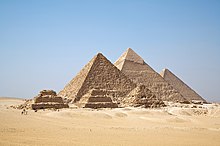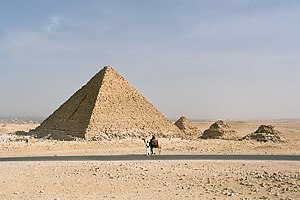Mykerinos pyramid
| Mykerinos pyramid | ||||||||||||||||||||||||||||||||||||||||||
|---|---|---|---|---|---|---|---|---|---|---|---|---|---|---|---|---|---|---|---|---|---|---|---|---|---|---|---|---|---|---|---|---|---|---|---|---|---|---|---|---|---|---|
|
||||||||||||||||||||||||||||||||||||||||||
The Mykerinos pyramid is the pyramid that the Pharaoh Mykerinos ( 4th Dynasty ) built between about 2540 and 2520 BC. When his tomb was built.
Edification
Menkaure or (Greek) Mykerinos was the son of Pharaoh Chephren , whose pyramid was previously also built in Giza. Mykerinos succeeded his father on the throne, but possibly only after an interim reign of Bicheris . Chephren was the son of Cheops and he was the son of Snefru , who had two pyramids over 100 meters high ( bent pyramid and red pyramid ) built in Dahshur . In the Old Kingdom, for example, a number of the great pyramids of Egypt were built by a line of kings of the 4th Dynasty over several generations.
Size and construction technology
The Mykerinos pyramid is by far the smallest of the three pyramids in Giza , and yet one of the ten tallest of all Egyptian pyramids. With a height of about 65 meters, it is not even half as high as the other two pyramids on the Giza Plateau, the Khafre pyramid at 143 meters and the Cheops pyramid at 146 meters.
The pyramid of Mykerinus was built with local limestone . Its inner core is designed as a step pyramid, as can be seen from the two steps that are exposed in the breach that was created later . Little remains of the panel. In the lower 16 layers, granite slabs were used, which, apart from a few polished areas at the entrance and the mortuary temple, remained unprocessed. The previously held opinion that the pyramid was completely clad with granite slabs has now been refuted. The unfinished work is interpreted as an indication that Pharaoh Menkaure died before his tomb was completed. His reign is not exactly known; it lasted from about 2530 to 2510 BC. Chr.
There are various possible explanations for the fact that the Mykerinos pyramid is significantly smaller than the two neighboring pyramids of Cheops and Chephren. Cited are u. a.
- Space problems on the Giza Plateau,
- too high construction costs (the successor Schepseskaf only built a mastaba tomb ),
- the turn to the sun cult of Re promoted the building of temples for the sun god.
Substructure
The entrance to the pyramid is about four meters high on the north side. A 32-meter-long shaft running downwards leads into an anteroom of 3.63 x 3.16 meters with narrow false doors , the so-called panel chamber . Three halyard blocking blocks are installed behind this chamber. From here the tunnel again leads horizontally to the center of the structure, the antechamber, which was carved into the natural rock below ground level. Above this entrance to the antechamber, another access shaft opens out from above, but it ends blindly in the base plate and was already abandoned during construction. Via an entrance in the floor of the antechamber, a short passage leads into the deeper burial chamber proper. A few steps below the passage branches off a side chamber, the niche chamber , which is provided with six niches (each measuring around 2.50 meters by 0.60 meters and 1.4 meters high), the meaning of which is unclear. The actual burial chamber measures 6.59 meters × 2.62 meters and is 3.43 meters high. It was completely covered with granite; the granite beams of the ceiling were processed so that the ceiling looks like a barrel vault.
In the burial chamber, Richard William Howard Vyse , when he advanced into the pyramid in 1837, found a magnificent dark stone sarcophagus without a cover, decorated with palace facade patterns . When transporting the sarcophagus to England, however , the ship Beatrice got caught in a storm and sank in 1838 together with its cargo. Vyse also discovered the remains of a human-shaped wooden coffin with the name of Mykerinos and human bones. According to Kurt Sethe , the coffin comes from the Saïtic epoch , the bones that are still present today, according to radiocarbon studies, come from Christian times.
A thorough study of the pyramid was not carried out until 1906 to 1924 by a team from Harvard University and the Museum of Fine Arts Boston under the direction of George Andrew Reisner . One of the most important results of the investigations is the finding that the substructure was changed three times during construction.
The pyramid complex

Like the two older pyramids at Giza , that of Mykerinos was also surrounded by a wall. In the south there are three secondary pyramids, which are now designated with the serial numbers GIII-a , GIII-b and GIII-c . All three have adobe chapels. GIII-a was most likely smoothly clad with pink granite and perhaps intended for Queen Chamerernebti II, one of Mykerinus' wives. GIII-b and GIII-c were step pyramids. The mummy of a young woman whose name is unknown was found in the burial chamber of GIII-b.
As usual, east of the pyramid is the mortuary temple made of limestone blocks. With a weight of over 200 tons, one of these blocks on the northwest corner is the largest monolith found in Giza to date. Reisner found that the walls had been finished with granite cladding and that the mortuary temple was made from simple mud bricks. While removing the bricks, he came across red leveling lines, names of workers and measurements that are unfortunately lost today. Fragments of a larger than life statue of the king made of alabaster were found in the temple itself . The more than 600 meter long path to the mortuary temple was also made of adobe bricks and probably never been completed (not covered, not covered). Reisner determined the location of the valley temple by extending the axis from the mortuary temple to the pathway. The foundations of the valley temple are still made of limestone; this was also completed with simple mud brick walls, which his son and successor Sheepseskaf probably had built. The famous statues of the king were also found in the valley temple:
- Mykerinos with his wife Chamerernebti II.
- Three statues of Mykerinos with the goddess Hathor and one goddess each (Bat-Gau, Hunds-Gau, Hasen-Gau).
Ship pits (barge graves) have not yet been found in the district.
see also: Necropolis of Giza
Attempted destruction
Towards the end of the 12th century, the Sultan of Egypt, Abd al-Malik al-Aziz Utman bin-Yusuf , Saladin's son and heir, tried to have the pyramids removed; he started with the Mykerinos pyramid. Finally, over the course of eight months, it turned out that the destruction would be just as expensive as the construction. It proved impossible to remove more than a stone or two a day. Using wedges, levers and ropes, attempts were made to move and crash the top stones, with the result that the stones were difficult to free after falling and hitting the sandy soil. Some stones were split with wedges and transported away with the help of carts. Far from having achieved his goal, Othman bin-Yussuf had the demolition operation ended. The pyramid was only damaged on the northern side, which today is evidence of a vertical breach up to 8 m deep.
See also
literature
- Mark Lehner : The first wonder of the world - The secrets of the Egyptian pyramids. Econ, Düsseldorf / Munich 1997, ISBN 3-430-15963-6 .
- Frank Müller-Römer : The construction of the pyramids in ancient Egypt , Utz 2011, ISBN 978-3-8316-4069-0 .
- Rainer Stadelmann : The Egyptian pyramids. From brick construction to the wonder of the world (= cultural history of the ancient world . Volume 30). 3rd, updated and expanded edition. Philipp von Zabern, Mainz 1997, ISBN 3-8053-1142-7 .
- Peter Lacovara: Giza, Menkaure pyramid complex. In: Kathryn A. Bard (Ed.): Encyclopedia of the Archeology of Ancient Egypt. Routledge, London 1999, ISBN 0-415-18589-0 , pp. 351-53.
- Miroslav Verner : The pyramids (= rororo non-fiction book No. 60890). Rowohlt-Taschenbuch-Verlag, Reinbek 1999, ISBN 3-499-60890-1 .
- Zahi Hawass : The Treasures of the Pyramids. Weltbild, Augsburg 2004, ISBN 3-8289-0809-8 .
- Alberto Siliotti: Pyramids. Pharaohs tombs of the Old and Middle Kingdom. Müller, Erlangen 2000, ISBN 3-86070-650-0 .
- Peter Jánosi : The Pyramids: Myth and Archeology Beck, Munich 2004, ISBN 3-406-50831-6 .
- Desmond Stewart: The pyramids and sphinx. Norton & Co, New York 1979, ISBN 978-0-88225-006-9 .
Web links
Individual evidence
- ^ Roman Gundacker: On the structure of the pyramid names of the 4th dynasty. In: Sokar. No. 18, 2009, pp. 26-30.
- ↑ Year numbers according to Schneider: Lexicon of the Pharaohs .
- ↑ Desmond Stewart: The pyramids and sphinx, by Desmond Stewart and the editors of the Newsweek Book Division. not stated edition, Newsweek, New York June 1, 1971, p. 101.
- ↑ Mark Lehner: The Complete Pyramids. Thames & Hudson, London 1999, ISBN 0-500-05084-8 , p. 41.
Coordinates: 29 ° 58 ′ 20 ″ N , 31 ° 7 ′ 40 ″ E








